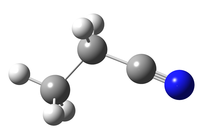|
The observed transitions were taken from
(1) H. Mäder, H. M. Heise, and H. Dreizler,
1974, Z. Naturforsch. 29a, 164;
(2) D. R. Johnson, F. J. Lovas, C. A. Gottlieb,
E. W. Gottlieb, M. M. Litvak, M. Guelin, and P. Thaddeus,
1977, Astrophys. J. 218, 370;
(3) J. Bourie, J. Demaison, A. Dubrulle, and D. Boucher,
1978, J. Mol. Spectrosc. 72,275;
(4) D. Boucher, A. Dubrulle, J. Demaison, and H. Dreizler,
1980, Z. Naturforsch. 35a, 1136;
(5) J. C. Pearson, K. V. L. N. Sastry, E. Herbst,
and F. C. De Lucia,
1994, Astrophys. J. Suppl. Ser. 93, 589;
(6) Y. Fukuyama, H. Odashima, K. Takagi, S. Tsunekawa,
1996, Astrophys. J. Suppl. Ser. 104, 329;
and from
(7) H. S. P. Müller, unpublished.
With respect to the Apr. 2007 entry, additional submillimeter
data were used in the fit. These have been reported
by
(8) C. S. Brauer, J. C. Pearson, B. J. Drouin, and S. Yu,
2009, Astrophys. J. Suppl. Ser. 184, 133.
Data with experimental uncertainties larger than 50 kHz
and 100 below and above 500 GHz, respectively,
as well as the data from (7) have not been merged.
Predictions with uncertainties exceeding 0.5 MHz should be
viewed with caution. However, such large uncertainties only
occur at energies which are unlikely to be accessed by
astronomical observations.
The data from (4) show resolved internal rotation of the
methyl group. These effects are expected to be insignificant
for astronomical observations. The A and E
frequencies have been averaged.
Data from (1) and (4) as well as part of the data from (7)
show resolved 14N hyperfine splitting which
is negligible in most instances. However, it may be resolved
for low values of J. Therefore, a
separate hyperfine calculation is provided for
J' ≤ 10 and frequencies below 92 GHz.
NOTE: The partition function
does not take into account the spin multiplicity
gI = 3 of the 14N nucleus !
Furthermore, energy levels up to J = 150 and
Ka = 70 have been considered in the calculation of
the partition function. This is sufficient up to 300 K.
At higher temperatures classical extrapolations are recommended.
The partition function values below refer to the ground
vibrational state only.
Vibrational correction factors have been derived for
the main isotopolog in the harmonic approximation.
The dipole moment was taken from
(9) H. M. Heise, H. Lutz, and H. Dreizler,
1974, Z. Naturforsch. 29a, 1345.
|
